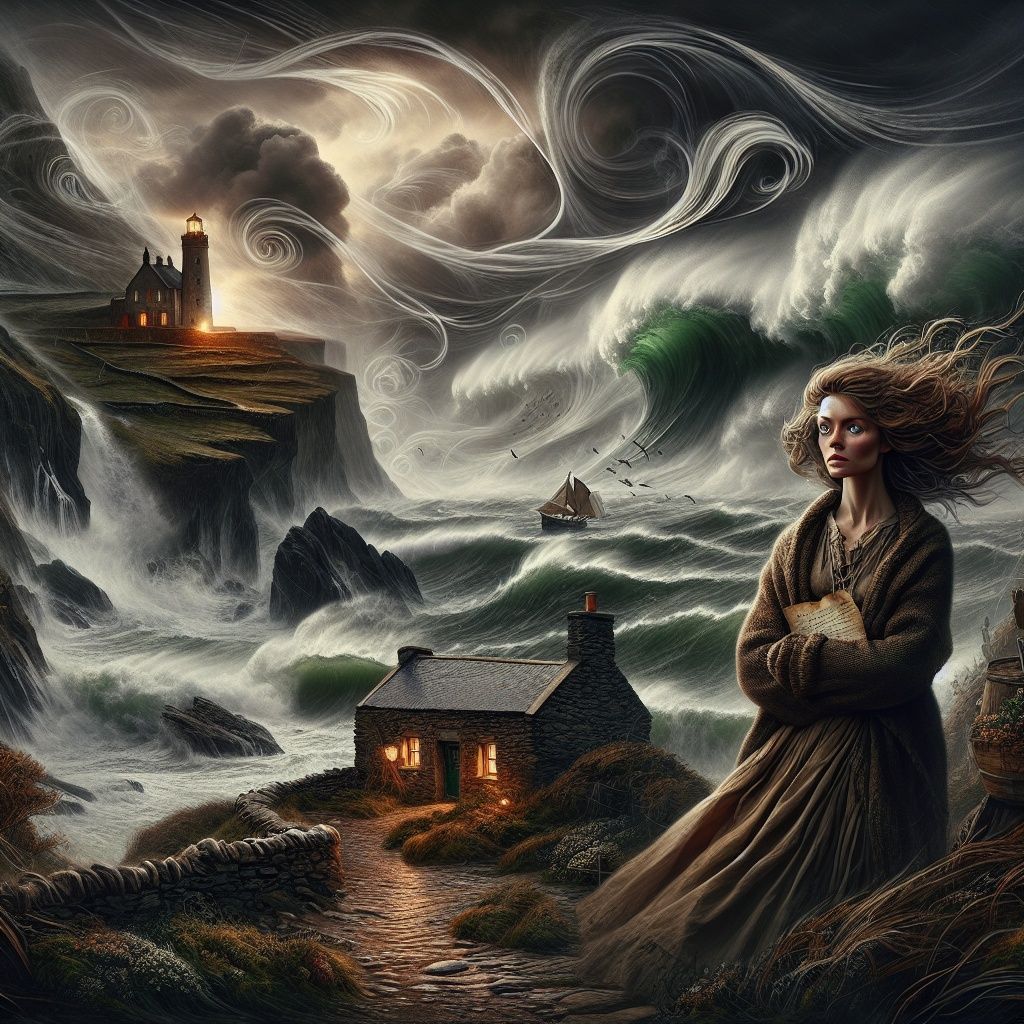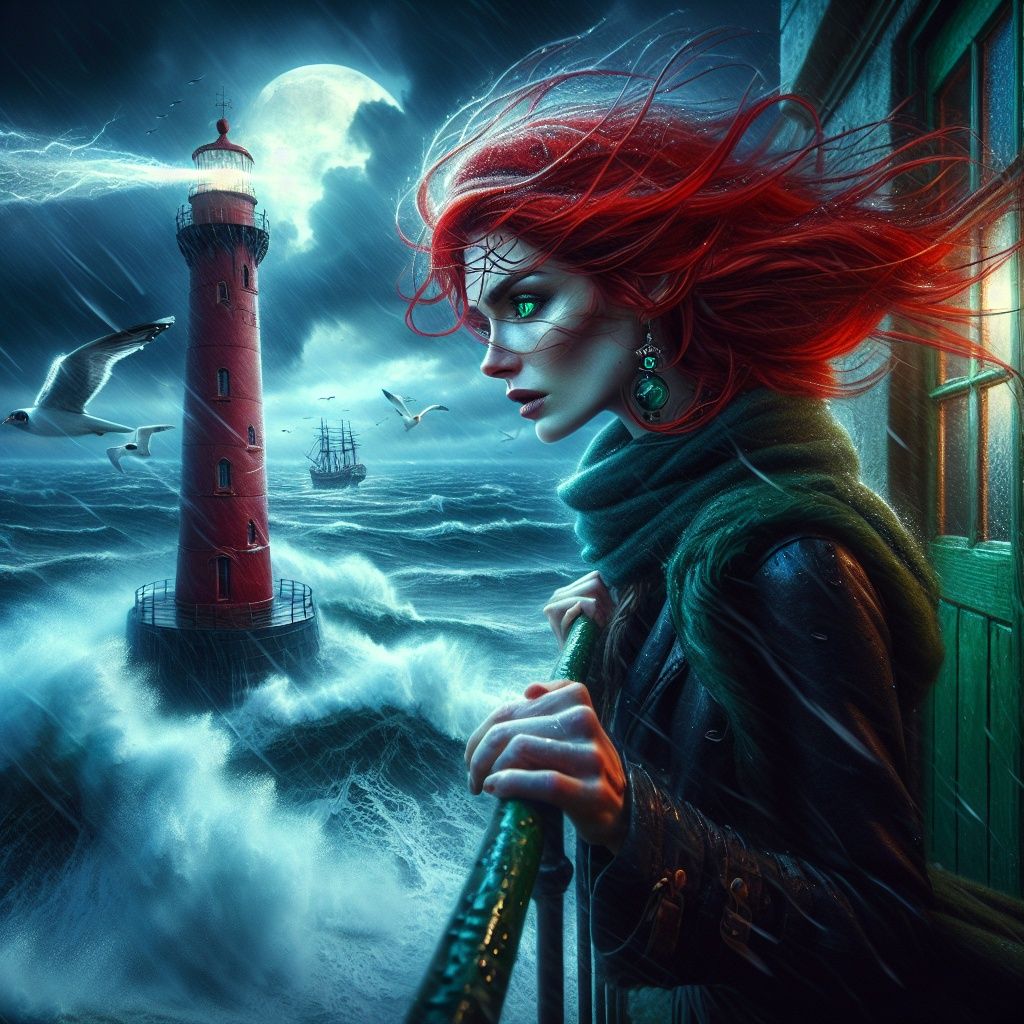6 Ianuarie 1839: The Night the Storm Stole Her World: The Tragic Tale of Aoife and the Unyielding Power of Love
On the tumultuous night of January 6, 1839, in a little village forgotten by the world on the west coast of Ireland, there lived a woman named Aoife. She had hair like the waves of the ocean during a storm and eyes green as emeralds, which seemed to hide the secrets of the entire world. That night, as the wind began to unleash its fury over the fragile houses of the village, Aoife sat alone in her modest hut, clutching an old letter and a faded photograph.

Her husband, Ciaran, had left months before at sea, a captain on a proud ship, promising her that he would return with stories of new worlds and enough gold to start their life anew, far from the poverty that gnawed at their days. However, as the wind howled and the window planks began to bend under an unseen force, Aoife felt her hope fading and her heart gripped by a dark premonition. The storm, later known as Oíche na Gaoithe Móire, seemed to mock the small community, destroying everything in its path. Houses were ripped from their foundations, roofs flew like leaves in the wind, and people sheltered as best they could, praying for the day to come and find them alive. Aoife, although frightened, felt deep in her soul that she had to do something. She couldn't stand by passively as her world was falling apart. So, dressing as warmly as she could and taking with her the letter and the photograph, she went out into the storm, determined to reach the lighthouse at the end of the village. The lighthouse, a sturdy construction, was the only place that seemed to withstand the fury of nature and, at the same time, the last place from where Ciaran could have been seen if, by a miracle, his ship had returned home.

As she battled against the wind that seemed to push her back with every step, Aoife remembered the promises made by Ciaran, the evenings spent together, their plans for the future. Each memory gave her the strength to continue, to not yield to the unleashed nature. Having reached the lighthouse, Aoife climbed the spiral staircase, reaching the top of the tower. From there, her gaze swept over the enraged sea, searching for any sign of her husband's ship. She pressed her palm against the cold glass and whispered a name, "Ciaran," as tears streamed down her cheeks, mixing with the wind-beaten rain.

Hours passed, and the storm began to calm down. The sun rose over a landscape of disaster, but in Aoife's heart, the night never ended. Ciaran did not return, and his ship was counted among those lost in the merciless sea. The story of Aoife became one of the many legends born on that tragic night, symbolizing the hope and love that can survive even in the darkest of times. Oíche na Gaoithe Móire permanently changed Ireland, but for Aoife, it changed every heartbeat, every breath of wind, reminding her of the night her world was taken by the storm.

Her husband, Ciaran, had left months before at sea, a captain on a proud ship, promising her that he would return with stories of new worlds and enough gold to start their life anew, far from the poverty that gnawed at their days. However, as the wind howled and the window planks began to bend under an unseen force, Aoife felt her hope fading and her heart gripped by a dark premonition. The storm, later known as Oíche na Gaoithe Móire, seemed to mock the small community, destroying everything in its path. Houses were ripped from their foundations, roofs flew like leaves in the wind, and people sheltered as best they could, praying for the day to come and find them alive. Aoife, although frightened, felt deep in her soul that she had to do something. She couldn't stand by passively as her world was falling apart. So, dressing as warmly as she could and taking with her the letter and the photograph, she went out into the storm, determined to reach the lighthouse at the end of the village. The lighthouse, a sturdy construction, was the only place that seemed to withstand the fury of nature and, at the same time, the last place from where Ciaran could have been seen if, by a miracle, his ship had returned home.

As she battled against the wind that seemed to push her back with every step, Aoife remembered the promises made by Ciaran, the evenings spent together, their plans for the future. Each memory gave her the strength to continue, to not yield to the unleashed nature. Having reached the lighthouse, Aoife climbed the spiral staircase, reaching the top of the tower. From there, her gaze swept over the enraged sea, searching for any sign of her husband's ship. She pressed her palm against the cold glass and whispered a name, "Ciaran," as tears streamed down her cheeks, mixing with the wind-beaten rain.

Hours passed, and the storm began to calm down. The sun rose over a landscape of disaster, but in Aoife's heart, the night never ended. Ciaran did not return, and his ship was counted among those lost in the merciless sea. The story of Aoife became one of the many legends born on that tragic night, symbolizing the hope and love that can survive even in the darkest of times. Oíche na Gaoithe Móire permanently changed Ireland, but for Aoife, it changed every heartbeat, every breath of wind, reminding her of the night her world was taken by the storm.
On the night of January 6, 1839, Ireland was hit by a strong storm known as the Night of the Big Wind (Oíche na Gaoithe Móire). The storm caused severe damage to properties and hundreds of deaths, being considered the worst storm to hit Ireland in the last 300 years. About 250-300 people lost their lives, and between 20 to 25% of houses in north Dublin were damaged or destroyed. Additionally, 42 ships were wrecked, and Liverpool also suffered significant damage. The storm left a strong mark on Ireland, becoming a part of Irish folk tradition and even influencing later policies, such as the introduction of pensions for the elderly.


Comments
Post a Comment